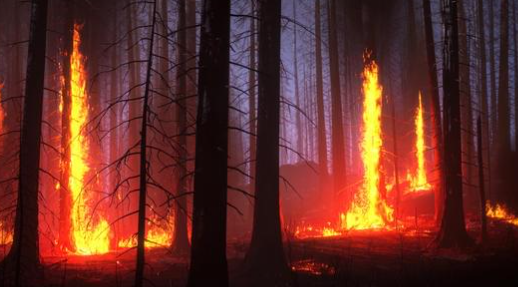September 21, 2024: Bridge Fire Continues to Endanger Communities in Angeles National Forest
The Bridge Fire, which erupted on September 8 close to Cattle Canyon Bridge within the Angeles National Forest, has now engulfed over 54,000 acres, necessitating mandatory evacuations in Mount Baldy Village and adjacent regions. Firefighters are battling steep landscapes and unpredictable winds, complicating containment endeavors. As of today, containment is at 49%, with more than 2,600 personnel assigned to the situation. The origin of the fire remains under investigation.
Individuals in the impacted zones have been relocated to shelters established by the Red Cross, while local officials have released air quality warnings due to substantial smoke. The fire has devastated 33 residences and poses a threat to thousands more. Governor Gavin Newsom has proclaimed a state of emergency in Los Angeles and San Bernardino counties to streamline access to federal assistance and resources. Community members are encouraged to remain updated through official sources and follow evacuation directives for their safety.
Bridge Fire Overview
As of September 21, 2024, the Bridge Fire continues to pose a significant threat to communities within the Angeles National Forest in California. Firefighters have made considerable efforts to combat the blaze, which has been challenging due to the terrain, weather conditions, and the dense vegetation present in the area. This fire has raised concerns among local residents, environmentalists, and government officials, all of whom are keeping a close watch on the situation as it evolves.
Current Status of the Fire
The Bridge Fire has reportedly burned thousands of acres since its ignition, spreading rapidly through dry brush and timber. Fire officials have indicated that the fire’s containment efforts have faced obstacles, factoring in erratic wind patterns and low humidity levels. Despite these challenges, the dedicated response teams have been working tirelessly, employing various firefighting strategies including aerial support and ground crews to combat the flames.
Impact on Local Communities
The fire has imposed a significant risk to nearby communities. Evacuation orders have been issued for various neighborhoods deemed at high risk, impacting residents and local businesses. Many individuals have had to abandon their homes and seek temporary shelter, which creates additional stress and uncertainty within the affected areas. Local authorities are providing resources to assist evacuees and ensure their safety, although the psychological toll of such situations can be profound.
Environmental Concerns
In addition to threats posed to human life and property, the Bridge Fire has raised considerable environmental concerns. The Angeles National Forest is home to diverse ecosystems and wildlife habitats, which are at risk from the advancing fire. Environmentalists have voiced their concerns regarding the long-term effects that such wildfires can have on soil erosion, water quality, and the overall health of the forest. Restoration efforts will be critical in addressing these impacts should the fire continue to grow.
Weather and Nature Factors
The conditions in Southern California have vividly illustrated the challenges in wildfire management. Warm temperatures and dry weather patterns have made the region particularly susceptible to forest fires. Firefighters have also been monitoring the potential for nighttime inversions, which can trap heat and smoke, complicating containment efforts. Predicting weather patterns will remain vital as officials strategize fire suppression techniques while planning for potential evacuations and resource allocation.
Community Response and Recovery Efforts
Community response to the Bridge Fire showcases resilience and solidarity among locals. Various organizations have mobilized to provide aid to those displaced by the flames. Fire relief fundraisers and donation drives are underway to support evacuees and assist firefighters with necessary supplies. Collaboration between local governments, non-profit organizations, and volunteers has been essential to providing a coordinated response in the face of adversity, illustrating the strength of community spirit amid challenging circumstances.
Looking Ahead: Strategies and Preparedness
With wildfires becoming an increasingly common occurrence in California, experts emphasize the importance of preparedness and proactive strategies. Agencies are urging local residents to develop fire safety plans, stay informed about evacuation routes, and create defensible spaces around homes. Moreover, the integration of updated data analytics into fire management is helping in predicting fire behavior and optimizing resources, which is crucial as the frequency and severity of wildfires rise with climate change.
Conclusion
The ongoing Bridge Fire illustrates the enduring threats posed by wildfires in California, highlighting the intersection of environmental conditions and community safety. While firefighters continue to work diligently, the situation remains fluid, and vigilance is paramount. As communities rally to support each other and resources are mobilized, the overarching goal remains: to protect lives, property, and the unique ecosystems of the Angeles National Forest. Future preparedness initiatives are essential, as is the commitment to recovery and environmental restoration.
FAQs
What started the Bridge Fire?
The exact cause of the Bridge Fire is still under investigation. Wildfires can be sparked by various factors, including natural causes like lightning or human activities such as campfires or equipment use.
How can residents help during this fire season?
Residents can help by staying informed about the fire situation, adhering to evacuation orders, assisting local relief efforts, and preparing their homes with fire defensible spaces and emergency kits.
What are the long-term effects of wildfires on the environment?
Long-term environmental impacts can include soil erosion, changes in water quality, loss of habitat for wildlife, and alterations in plant communities. Reforestation and habitat restoration are typically needed after such events.
Are there resources available for displaced residents?
Yes, local government agencies and nonprofit organizations often provide resources such as shelters, food assistance, and psychological support to help displaced residents during wildfire emergencies.
What steps are being taken to prevent future wildfires?
Future prevention efforts may include controlled burns, vegetation management, public education campaigns, and investments in more robust firefighting technologies and infrastructure to minimize risks associated with wildfires.

